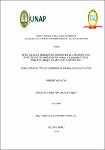Efectos de la densidad de siembra en el crecimiento de postlarvas de banda negra, Myleus schomburgkii (Pisces, Serrasalmidae), en ambiente controlado
Abstract
En el presente trabajo de investigación se evaluó el efecto de la densidad de siembra en el crecimiento de postlarvas de banda negra, Myleus schomburgkii en ambiente controlado. El estudio fue realizado del 27 de febrero al 27 de marzo del 2012, en el Centro de Producción e Investigación – Aquayap E.I.R.L, ubicado en el Km 3.5 al margen derecho de la Av. Abelardo Quiñones a los 03° 46' 12.7'' latitud sur y 73° 17' 14.3'' longitud oeste, al sur este de la ciudad de Iquitos, Distrito de San Juan Bautista, Provincia de Maynas, Departamento de Loreto.
El diseño experimental que se utilizó fue el DCA (Diseño Completamente al Azar), se utilizaron cuatro tratamientos (5, 10, 15 y 20 ind/L) y tres repeticiones, haciendo un total de doce unidades experimentales; utilizando un total de 450 larvas obtenidas del medio natural con peso y longitud promedio inicial de 0.01 g y 1.07 cm.
El alimento suministrado tuvo un tenor proteico de 26%, con una tasa de alimentación del 6% de la biomasa y moina (ad libitum), con frecuencia alimenticia de 3 veces al día.
Los datos obtenidos a los 30 días de cultivo, con peso y longitud promedio final de: 3.27 cm y 0.97 g para el T1, 2.3 cm y 0.83 g para el T2, 1.77 cm y 0.15g para el T3, y 1.63 cm y 0.11 g para el T4; mostrando diferencia significativa en peso (T1> T2> T3=T4).
Los valores promedios de los parámetros físico-químicos del agua registrados a lo largo del proceso experimental fueron los siguientes: temperatura 26.3 °C, oxígeno disuelto 4.45 mg/L y pH 7.0, valores están dentro de los rangos para la crianza de esta especie.
Se concluye que el Tratamiento 1 (5 ind/L) obtuvo mejores resultados, siendo el tratamiento con mayor crecimiento de peso y crecimiento en longitud. In this research work, the effect of sowing density on the growth of black-band postlarvae, Myleus schomburgkii in a controlled environment, was evaluated. The study was conducted from February 27 to March 27, 2012, at the Center for Production and Research - Aquayap EIRL, located at Km 3.5 on the right bank of Av. Abelardo Quiñones at 03 ° 46 '12.7' 'latitude south and 73 ° 17 '14.3' 'west longitude, south east of the city of Iquitos, District of San Juan Bautista, Province of Maynas, Department of Loreto.
The experimental design that was used was the DCA (Completely Random Design), four treatments (5, 10, 15 and 20 ind / L) and three repetitions were used, making a total of twelve experimental units; using a total of 450 larvae obtained from the natural environment with an initial average weight and length of 0.01 g and 1.07 cm.
The food supplied had a protein content of 26%, with a feeding rate of 6% of biomass and moina (ad libitum), with a food frequency of 3 times a day.
The data obtained at 30 days of cultivation, with weight and final average length of: 3.27 cm and 0.97 g for T1, 2.3 cm and 0.83 g for T2, 1.77 cm and 0.15g for T3, and 1.63 cm and 0.11 g for T4; showing significant difference in weight (T1> T2> T3 = T4).
The average values of the physical-chemical parameters of the water recorded throughout the experimental process were the following: temperature 26.3 ° C, dissolved oxygen 4.45 mg / L and pH 7.0, values are within the ranges for the breeding of this species.
It is concluded that Treatment 1 (5 ind / L) obtained better results, being the treatment with greater weight growth and growth in length.
Collections
- Tesis [145]
The following license files are associated with this item:


